Recording a sales order

Helpful Hint!
If you are completing our software practice set,
sales orders are to be recorded in the Sales - New Item window by selecting the ORDER option.
The sales order is to be converted to an invoice when the
inventory is delivered.
One of the first steps in the sales cycle is receiving an order from a customer.
In general, there are two ways this information can be recorded.
The first way is to immediately create a
sales order and then to convert the sales order to a sales invoice when the items are delivered.
Alternatively, if the items are to be delivered immediately, the second way
is to not create a sales order and to just create the sales invoice
for the sale.
The method chosen does have consequences as to when
your MYOB software records the information from the sale into the general ledger accounts.
The general ledger accounts are updated when the
sales invoice is saved, not when the
sales order is saved.
When the sales order is saved, your MYOB software records the sales order information
into the Sales Register - Orders tab. Entries in the Sales Register - Orders tab are not
posted to the general ledger accounts. It is only when the sales order is converted to a
credit sale (and a sales invoice is created and saved) that the general ledger accounts are updated to reflect
the number of items shipped.
You can learn how to convert a sales order to a credit sale
(and how to view the sales orders in the Sales Register - Orders tab)
in the
Sales transactions
page in this learning centre.
Sales orders are useful
if, for example, you do not have the merchandise on hand to fulfil an
entire order from a customer straight away.
You can use the sales order functionality to track how much of the merchandise you have
delivered and how much is still on order.
This topic shows you where and how to enter sales order information into your MYOB software.
To record a sales order, open the Sales Command Centre and select Enter Sales.
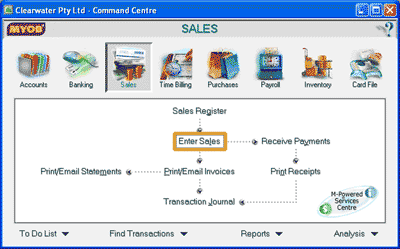
This displays the Sales - New Item window. Notice in the top left hand corner of this window there is a
field that in this example currently says INVOICE.
Click the arrow next to this field and select ORDER.

Helpful Hint!
If you are completing our software practice set
and the title of the window is not Sales - New Item, it is
because your MYOB software is displaying a different layout for that window. To change this to the Sales - New Item window,
click the Layout icon at the bottom of the window. In the Select Layout window that appears, select Item and
click the OK button. The title of the window should automatically change to Sales - New Item.
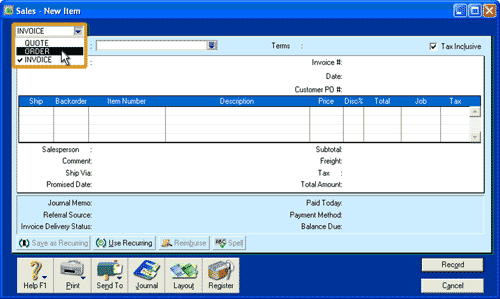
You should now notice that the colour of the window has turned from blue to yellow. It is here
where you can enter the details of the sales order into your MYOB software.
The following screenshots and reference table show step-by-step instructions on
how to enter a sales order into the Sales - New Item window.
Note that each step is assigned a
reference number to help you identify the appropriate field or icon in the
screenshots.
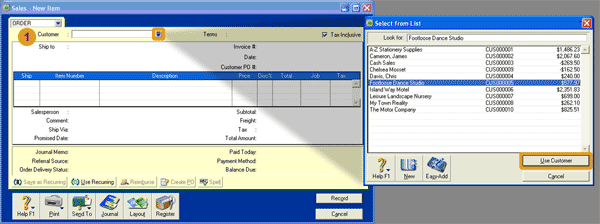
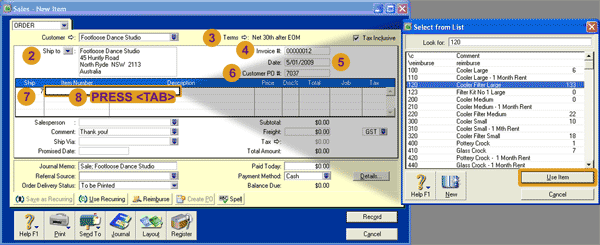
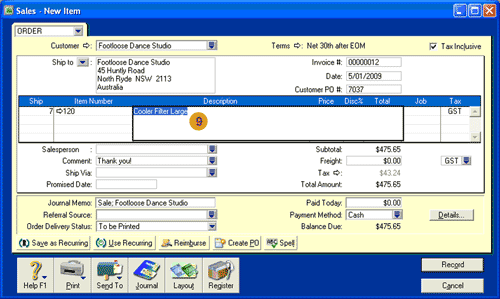
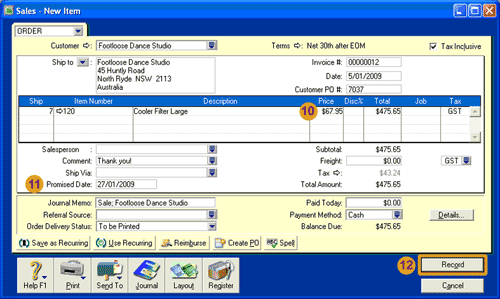
| Step |
MYOB software field or icon |
Action |
 |
Customer |
Click the search icon to open the Select From List window where you can select the customer
to which the order relates to. Click the Use Customer button to select the customer. Notice that
when you select the customer, your MYOB software automatically populates certain fields with
information about the customer that you entered when you added the customer into your MYOB software
during the setup process. You can accept that information or manually change it for this
sales order.
|
 |
Ship To |
This field is automatically populated when you select the customer. You can accept this information
or change the Ship To details if required by selecting an alternate address from those you have
already set up for that customer.
|
 |
Terms |
This field is automatically populated when you select the customer. You can accept this information
or change it for this sales order by clicking on the zoom arrow. |
 |
Invoice # |
Accept the invoice number your MYOB software automatically assigns to this invoice or enter the invoice number you
wish to use. Note that although we are entering a sales order, an invoice number is assigned now
so the sales order can be matched to the invoice created
when the goods are delivered to the customer.
|
 |
Date |
Enter the date of the sales order.
|
 |
Customer PO #
|
Enter the customer's purchase order number in the Customer PO # field if known.
|
 |
Ship |
Enter the quantity of the first item ordered.
|
 |
Item Number |
Enter the item number of the item of inventory ordered. If you do not already know the item number,
click into this cell to select the cell. You should notice that a box appears around the cell.
You should then press <tab> on your keyboard to display the Select from List window
where you can scroll through the list of inventory items. Click on the appropriate item of inventory to select it,
then click the Use Item button.
|
 |
Description |
When you select the item of inventory using the Item Number field, your MYOB software automatically populates
this field with the longer description of the item of inventory. Read this description to
check that you have selected the correct item. Then press <tab> on your
keyboard to move to the next field.
|
 |
Price,
Total,
Tax
|
Your MYOB software automatically populates these fields with the default information
specified when that item of inventory was set up. You can either accept the default information
or enter any changes directly into the appropriate field.
Note that if you change the price, your MYOB software
automatically calculates the new Total for that number of items. Alternatively if you change
the amount recorded in the Total column,
your MYOB software will calculate the percentage discount and record it in the Disc% column.
|
| Helpful hint!
|
You can enter additional items of inventory ordered by repeating steps
7 to 10 in a new row.
|
 |
Promised Date
|
Enter the date by which the goods are required to have shipped.
|
 |
Record button
|
Once you have reviewed the information entered for the sales order, remember to click the
Record button to record the sales order.
|
Return to the top